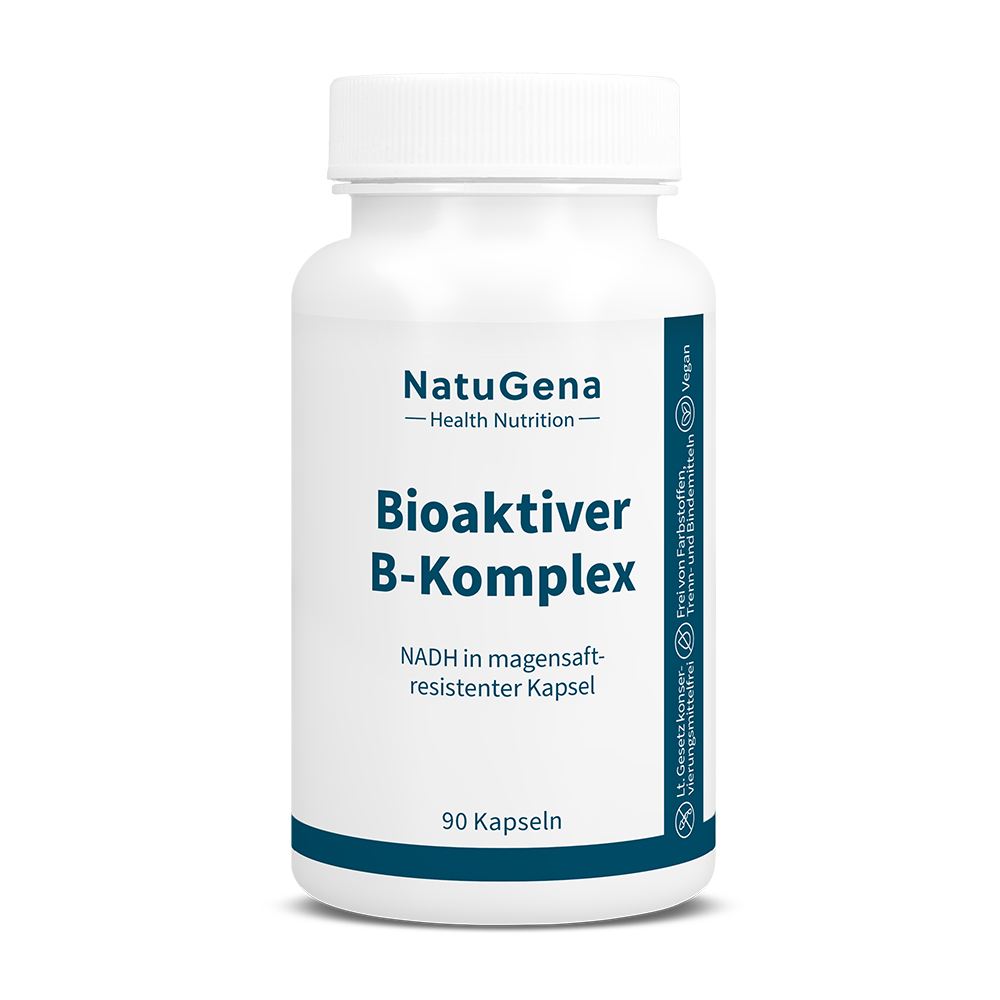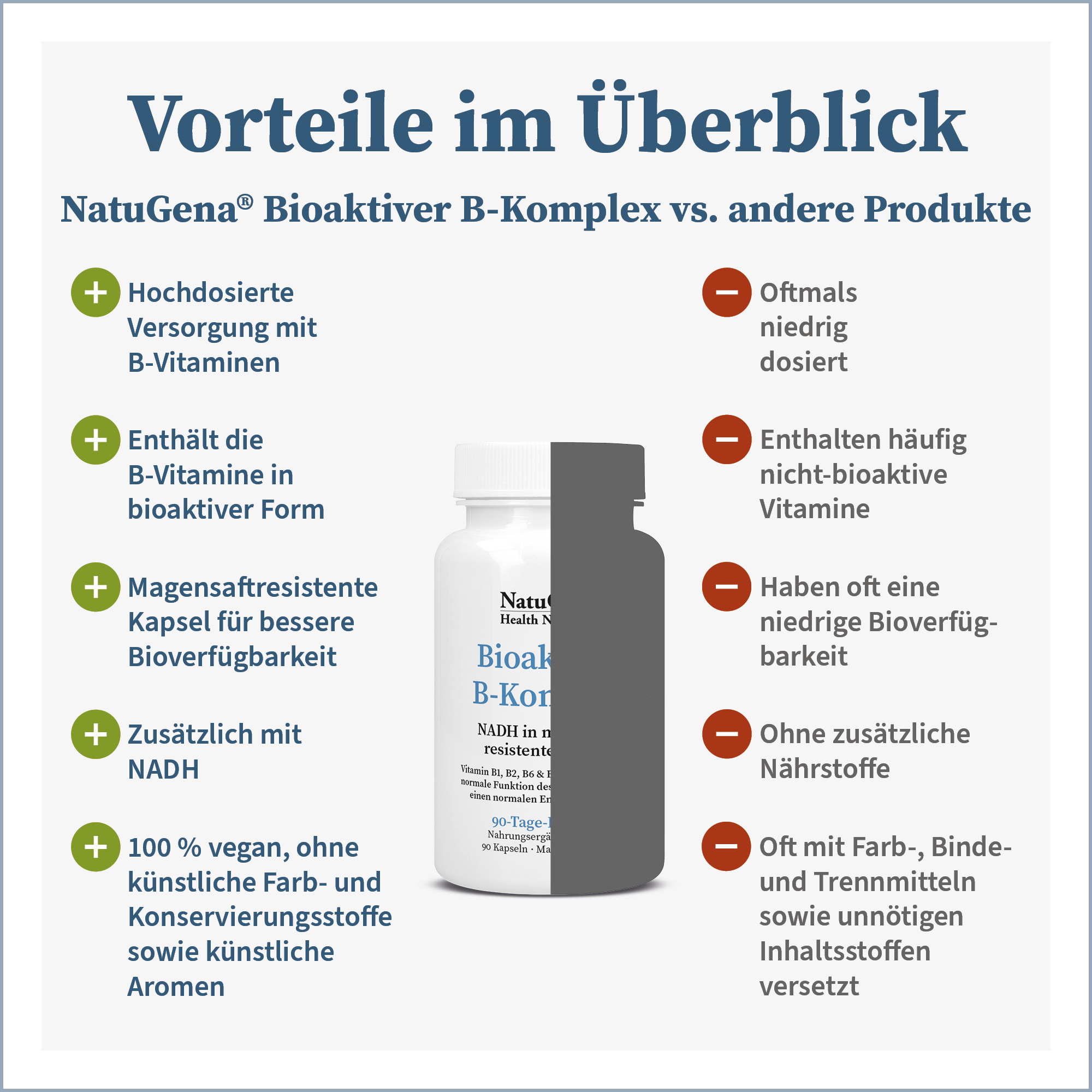Bioaktiver B-Komplex
NADH in magensaftresistenter KapselNahrungsergänzungsmittel
90 Kapseln (Größe 1) für 90 Tage
- bioaktive B-Vitamine sorgen für eine optimale Aufnahme und Verwertung
- Vitamin B6, B12, Thiamin (B1), Riboflavin (B2) und Niacin (B3) tragen zu einem normalen Energiestoffwechsel und zu einer normalen Funktion des Nervensystems bei
- ergänzt durch 7 mg NADH pro Kapsel
- Niacin in Form von Inositol-Hexanicotinat vermeidet typische Flush-Reaktionen
- 100 % vegan, laktose- und glutenfrei
- höchste Rohstoffqualität aus deutscher Herstellung
- Blogartikel zu B-Vitaminen: Unscheinbar, aber leistungsstark – die B-Vitamine
Wenn Sie ein Präparat mit Vitamin B1–B12 suchen, schauen Sie sich das Produkt HydroVitamine an! (Enthält alle 14 B-Vitamine und Vitamin C)
| Anzahl | Preis |
|---|---|
| ab 1 | 29,95 € |
| ab 3 | 26,95 € |
| ab 5 | 24,95 € |
Artikel-Nr.: 2018203
PPN/PZN: 11 19549734 46 (PZN = mittlere Ziffern)
EAN: 4260633572039
Grundpreis: 955,34 € pro Kilogramm
inkl. 7% MwSt., zzgl. Versand Bestellbar
NatuGena Bioaktiver B-Komplex enthält 7 wichtige bioaktive B-Vitamine in einer Kapsel, um den Körper gezielt bei seiner täglichen Arbeit zu unterstützen.
Besonders hervorzuheben ist die hohe Bioverfügbarkeit der B-Vitamine, was bedeutet, dass sie direkt vom Körper aufgenommen und verwertet werden können. B6, B12, Thiamin (B1), Riboflavin (B2) und Niacin (B3) tragen zu einem normalen Energiestoffwechsel und zu einer normalen Funktion des Nervensystems bei. Pantothensäure (B5) trägt zu einer normalen geistigen Leistung und zur Verringerung von Müdigkeit und Ermüdung bei. Dank des Zusammenspiels dieser Nährstoffe wird der Körper optimal mit wichtigen Bausteinen für die Energieproduktion versorgt.
NADH
NADH (Nicotinamid-Adenin-Dinukleotid) ist die reduzierte Form des Coenzyms NAD: beide kommen in allen lebenden Zellen vor und übernehmen dort vielfältige Aufgaben. Die bioaktive Verbindung NADH ist besonders wichtig für verschiedene biochemische Prozesse und spielt eine zentrale Rolle im gesamten Stoffwechsel. NADH wird in den Mitochondrien – den „Kraftwerken“ der Zellen – gebildet und ist an zahlreichen Stoffwechselwegen beteiligt. NADH kommt in bestimmten Lebensmitteln wie Fleisch, Fisch und Geflügel vor. Für Menschen, die weniger tierische Produkte konsumieren, kann es eine Herausforderung sein, NADH ausschließlich über die Ernährung aufzunehmen. Qualitativ hochwertiges NADH wird in modernen Verfahren hergestellt, die seine Stabilität und Bioverfügbarkeit unterstützen.
Inositol-Hexanicotinat
NatuGena Bioaktiver B-Komplex enthält zudem Inositol-Hexanicotinat, eine spezielle Verbindung aus Inositol und Nicotinsäure, die zur Familie der B-Vitamine gehört. Diese Form von Niacin, oft als „Flush-freies Niacin“ bezeichnet, ist besonders bekannt dafür, dass sie im Gegensatz zu herkömmlichem Niacin keine Wärme- oder Rötungsreaktionen („Flush“) hervorruft. Inositol-Hexanicotinat besteht aus sechs Molekülen Nicotinsäure, die an ein Inositol-Molekül gebunden sind, wodurch eine verzögerte Freisetzung ermöglicht wird. Diese langsam freisetzende Eigenschaft von Inositol-Hexanicotinat sorgt für eine gleichmäßige Verfügbarkeit im Körper und wird oft als sanfte Alternative zu anderen Formen von Niacin verwendet.
Mit nur einer Kapsel täglich reicht eine Packung für drei Monate. Bioaktiver B-Komplex ist vegan, glutenfrei und laktosefrei.
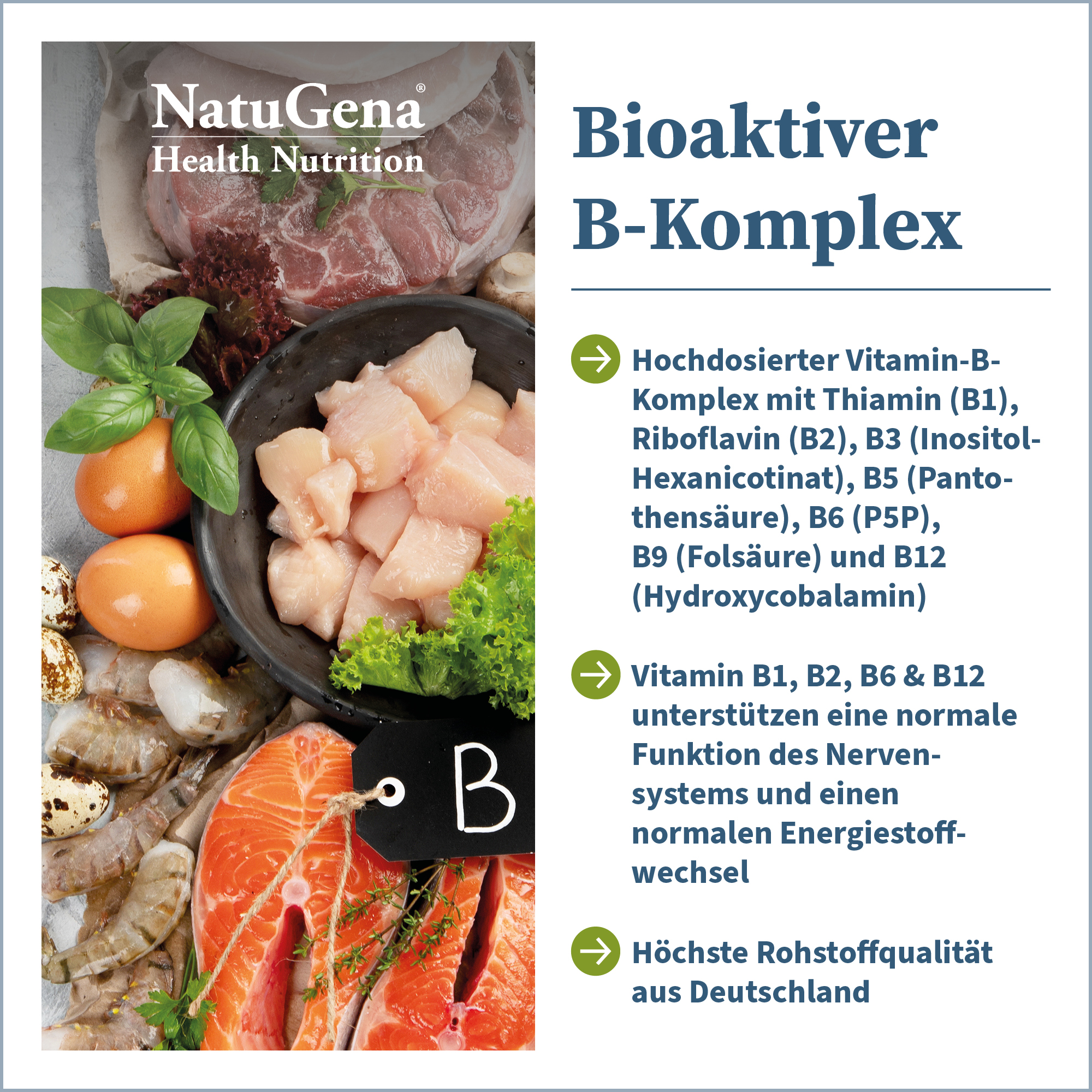
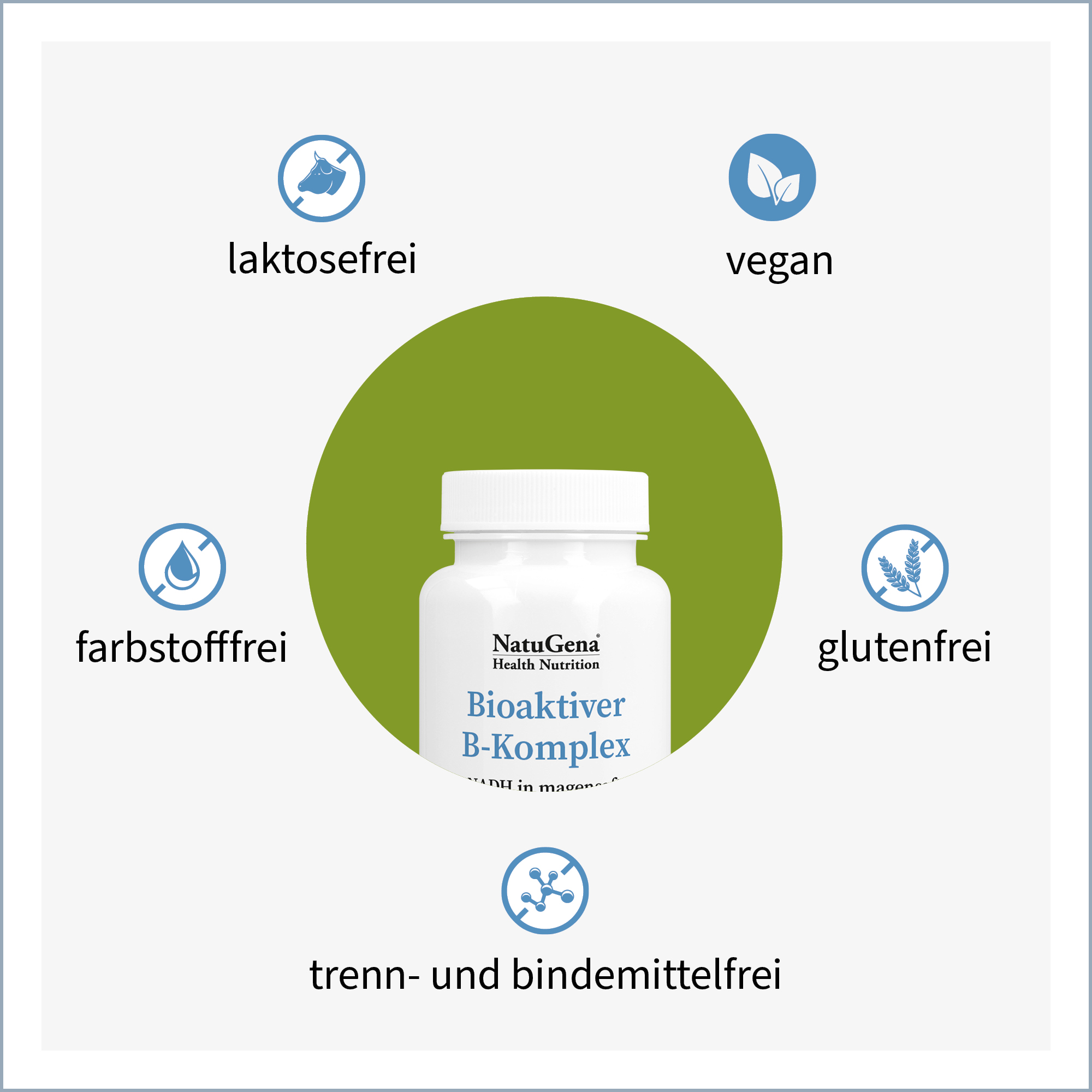
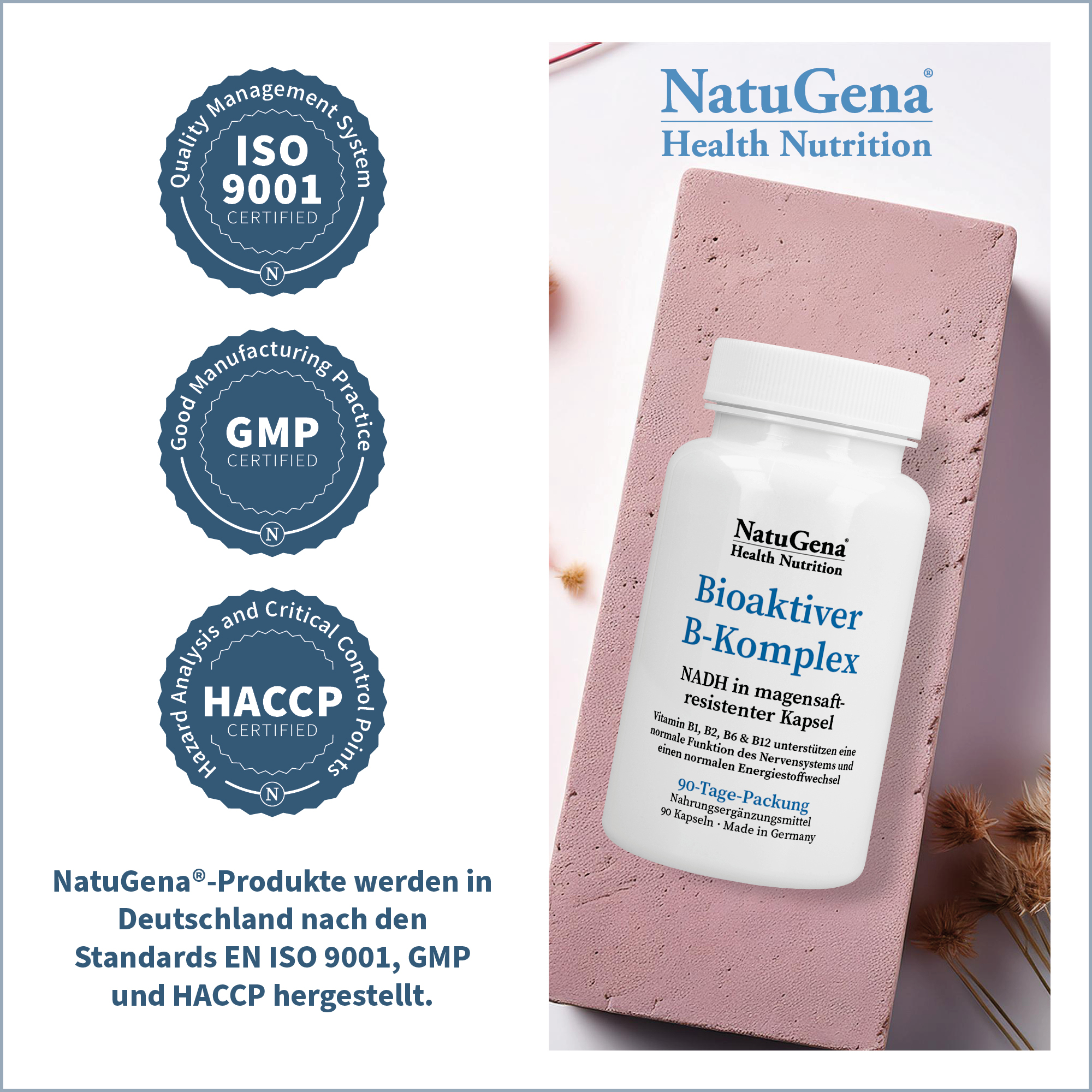

Verzehrempfehlung
1-mal täglich 1 Kapsel. Optimal ist der Verzehr mindestens 30 Minuten vor oder 90 Minuten nach einer Mahlzeit mit 250 ml stillem, lauwarmem Wasser.
Hinweise
Nahrungsergänzungsmittel sollten nicht als Ersatz für eine ausgewogene und abwechslungsreiche Ernährung sowie für eine gesunde Lebensweise verwendet werden. Außerhalb der Reichweite von kleinen Kindern aufbewahren. Verschlossen, kühl, trocken und lichtgeschützt lagern. Die angegebene empfohlene tägliche Verzehrsmenge darf nicht überschritten werden. Bei Einnahme von Antidepressiva nur in Rücksprache mit Ihrem Arzt einnehmen.
Inhaltsstoffe
| Inhaltsstoffe | Tagesdosis | NRV¹ |
|---|---|---|
| NADH | 7 mg | |
| Vitamin B1 (Thiamin) | 10 mg | 909 |
| Vitamin B2 (R5P; bioaktiv) | 5 mg | 357 |
| Vitamin B3 (Inositol-Hexanicotinat) | 20 mg | 125 |
| Vitamin B5 (Pantothensäure) | 20 mg | 333 |
| Vitamin B6 (P5P; bioaktiv) | 5 mg | 357 |
| Vitamin B9 (Folsäure 5MTHF; bioaktiv) | 100μg | 50 |
| Vitamin B12 (Hydroxycobalamin; bioaktiv) | 100μg | 4 000 |
Zusammensetzung
Magnesiumtaurat, magensaftresistente Überzugsmittel: Hydroxypropylmethylcellulose (HPMC); Calcium-D-Pantothenat, Inositol-Hexanicotinat, Thiaminhydrochlorid, Nicotinamid-Adenin-Dinukleotid, Riboflavin-5-Phosphat, Pyridoxal-5-Phosphat, 5-Methyltetrahydrofolat, Hydroxycobalamin.
Der Unterschied zwischen bioaktiver B-Komplex und HydroVitamine
HydroVitamine bioaktiver Vitamin-B- und -C-Komplex enthält mehr verschiedene B-Vitamine und die Verzehrempfehlung beträgt 3 Kapseln pro Tag. Beim Bioaktiver B-Komplex die Dosierung niedriger und die Verzehrempfehlung liegt bei nur einer 1 Kapsel täglich.
HydroVitamine ist hochdosiert und wird oft therapeutisch eingesetzt, um Mängel auszugleichen, wohin gegen bioaktiver B-Komplex mit geringeren Mengen sich sehr gut zur Prävention eignet.
Um HydroVitamine zur Prävention zu nutzen, nehmen viele Anwender auch nur 1-2 Kapseln täglich.
Kein Arzneimittel
Nahrungsergänzungsmittel: Die angegebene empfohlene tägliche Verzehrmenge darf nicht überschritten werden. Kein Ersatz für eine ausgewogene und abwechslungsreiche Ernährung sowie für eine gesunde Lebensweise.
Reinsubstanzen-Prinzip
Nur Wirkstoffe (keine Hilfsstoffe, keine Farbstoffe, laut Gesetz keine Konservierungsstoffe, keine technologischen Zusätze wie Binde- und Trennmittel, keine versteckten Zusatzstoffe, frei von Gluten, Geschmacksverstärkern, Lactose, Aromen, Soja).
Rechtlicher Hinweis
Dieses Produkt dient der Ernährung und berührt deshalb nicht das Heilmittelwerbegesetz (HWG). Ein guter Ernährungsstatus kann dem Organismus helfen Erkrankungen vorzubeugen oder diese zu überwinden. Alle zu dem Produkt getroffenen Aussagen beschreiben Eigenschaften und physiologische Wirkungen, die bei Konsumenten natürlicherweise unterschiedlich ausfallen können, und stellen keine Heil- oder Gesundheitsversprechen dar.
NatuGena Bioaktiver B-Komplex enthält 7 wichtige bioaktive B-Vitamine in einer Kapsel, um den Körper gezielt bei seiner täglichen Arbeit zu unterstützen.
Besonders hervorzuheben ist die hohe Bioverfügbarkeit der B-Vitamine, was bedeutet, dass sie direkt vom Körper aufgenommen und verwertet werden können. B6, B12, Thiamin (B1), Riboflavin (B2) und Niacin (B3) tragen zu einem normalen Energiestoffwechsel und zu einer normalen Funktion des Nervensystems bei. Pantothensäure (B5) trägt zu einer normalen geistigen Leistung und zur Verringerung von Müdigkeit und Ermüdung bei. Dank des Zusammenspiels dieser Nährstoffe wird der Körper optimal mit wichtigen Bausteinen für die Energieproduktion versorgt.
NADH
NADH (Nicotinamid-Adenin-Dinukleotid) ist die reduzierte Form des Coenzyms NAD: beide kommen in allen lebenden Zellen vor und übernehmen dort vielfältige Aufgaben. Die bioaktive Verbindung NADH ist besonders wichtig für verschiedene biochemische Prozesse und spielt eine zentrale Rolle im gesamten Stoffwechsel. NADH wird in den Mitochondrien – den „Kraftwerken“ der Zellen – gebildet und ist an zahlreichen Stoffwechselwegen beteiligt. NADH kommt in bestimmten Lebensmitteln wie Fleisch, Fisch und Geflügel vor. Für Menschen, die weniger tierische Produkte konsumieren, kann es eine Herausforderung sein, NADH ausschließlich über die Ernährung aufzunehmen. Qualitativ hochwertiges NADH wird in modernen Verfahren hergestellt, die seine Stabilität und Bioverfügbarkeit unterstützen.
Inositol-Hexanicotinat
NatuGena Bioaktiver B-Komplex enthält zudem Inositol-Hexanicotinat, eine spezielle Verbindung aus Inositol und Nicotinsäure, die zur Familie der B-Vitamine gehört. Diese Form von Niacin, oft als „Flush-freies Niacin“ bezeichnet, ist besonders bekannt dafür, dass sie im Gegensatz zu herkömmlichem Niacin keine Wärme- oder Rötungsreaktionen („Flush“) hervorruft. Inositol-Hexanicotinat besteht aus sechs Molekülen Nicotinsäure, die an ein Inositol-Molekül gebunden sind, wodurch eine verzögerte Freisetzung ermöglicht wird. Diese langsam freisetzende Eigenschaft von Inositol-Hexanicotinat sorgt für eine gleichmäßige Verfügbarkeit im Körper und wird oft als sanfte Alternative zu anderen Formen von Niacin verwendet.
Mit nur einer Kapsel täglich reicht eine Packung für drei Monate. Bioaktiver B-Komplex ist vegan, glutenfrei und laktosefrei.




Verzehrempfehlung
1-mal täglich 1 Kapsel. Optimal ist der Verzehr mindestens 30 Minuten vor oder 90 Minuten nach einer Mahlzeit mit 250 ml stillem, lauwarmem Wasser.
Hinweise
Nahrungsergänzungsmittel sollten nicht als Ersatz für eine ausgewogene und abwechslungsreiche Ernährung sowie für eine gesunde Lebensweise verwendet werden. Außerhalb der Reichweite von kleinen Kindern aufbewahren. Verschlossen, kühl, trocken und lichtgeschützt lagern. Die angegebene empfohlene tägliche Verzehrsmenge darf nicht überschritten werden. Bei Einnahme von Antidepressiva nur in Rücksprache mit Ihrem Arzt einnehmen.
Inhaltsstoffe
| Inhaltsstoffe | Tagesdosis | NRV¹ |
|---|---|---|
| NADH | 7 mg | |
| Vitamin B1 (Thiamin) | 10 mg | 909 |
| Vitamin B2 (R5P; bioaktiv) | 5 mg | 357 |
| Vitamin B3 (Inositol-Hexanicotinat) | 20 mg | 125 |
| Vitamin B5 (Pantothensäure) | 20 mg | 333 |
| Vitamin B6 (P5P; bioaktiv) | 5 mg | 357 |
| Vitamin B9 (Folsäure 5MTHF; bioaktiv) | 100μg | 50 |
| Vitamin B12 (Hydroxycobalamin; bioaktiv) | 100μg | 4 000 |
Zusammensetzung
Magnesiumtaurat, magensaftresistente Überzugsmittel: Hydroxypropylmethylcellulose (HPMC); Calcium-D-Pantothenat, Inositol-Hexanicotinat, Thiaminhydrochlorid, Nicotinamid-Adenin-Dinukleotid, Riboflavin-5-Phosphat, Pyridoxal-5-Phosphat, 5-Methyltetrahydrofolat, Hydroxycobalamin.
Der Unterschied zwischen bioaktiver B-Komplex und HydroVitamine
HydroVitamine bioaktiver Vitamin-B- und -C-Komplex enthält mehr verschiedene B-Vitamine und die Verzehrempfehlung beträgt 3 Kapseln pro Tag. Beim Bioaktiver B-Komplex die Dosierung niedriger und die Verzehrempfehlung liegt bei nur einer 1 Kapsel täglich.
HydroVitamine ist hochdosiert und wird oft therapeutisch eingesetzt, um Mängel auszugleichen, wohin gegen bioaktiver B-Komplex mit geringeren Mengen sich sehr gut zur Prävention eignet.
Um HydroVitamine zur Prävention zu nutzen, nehmen viele Anwender auch nur 1-2 Kapseln täglich.
Kein Arzneimittel
Nahrungsergänzungsmittel: Die angegebene empfohlene tägliche Verzehrmenge darf nicht überschritten werden. Kein Ersatz für eine ausgewogene und abwechslungsreiche Ernährung sowie für eine gesunde Lebensweise.
Reinsubstanzen-Prinzip
Nur Wirkstoffe (keine Hilfsstoffe, keine Farbstoffe, laut Gesetz keine Konservierungsstoffe, keine technologischen Zusätze wie Binde- und Trennmittel, keine versteckten Zusatzstoffe, frei von Gluten, Geschmacksverstärkern, Lactose, Aromen, Soja).
Rechtlicher Hinweis
Dieses Produkt dient der Ernährung und berührt deshalb nicht das Heilmittelwerbegesetz (HWG). Ein guter Ernährungsstatus kann dem Organismus helfen Erkrankungen vorzubeugen oder diese zu überwinden. Alle zu dem Produkt getroffenen Aussagen beschreiben Eigenschaften und physiologische Wirkungen, die bei Konsumenten natürlicherweise unterschiedlich ausfallen können, und stellen keine Heil- oder Gesundheitsversprechen dar.
